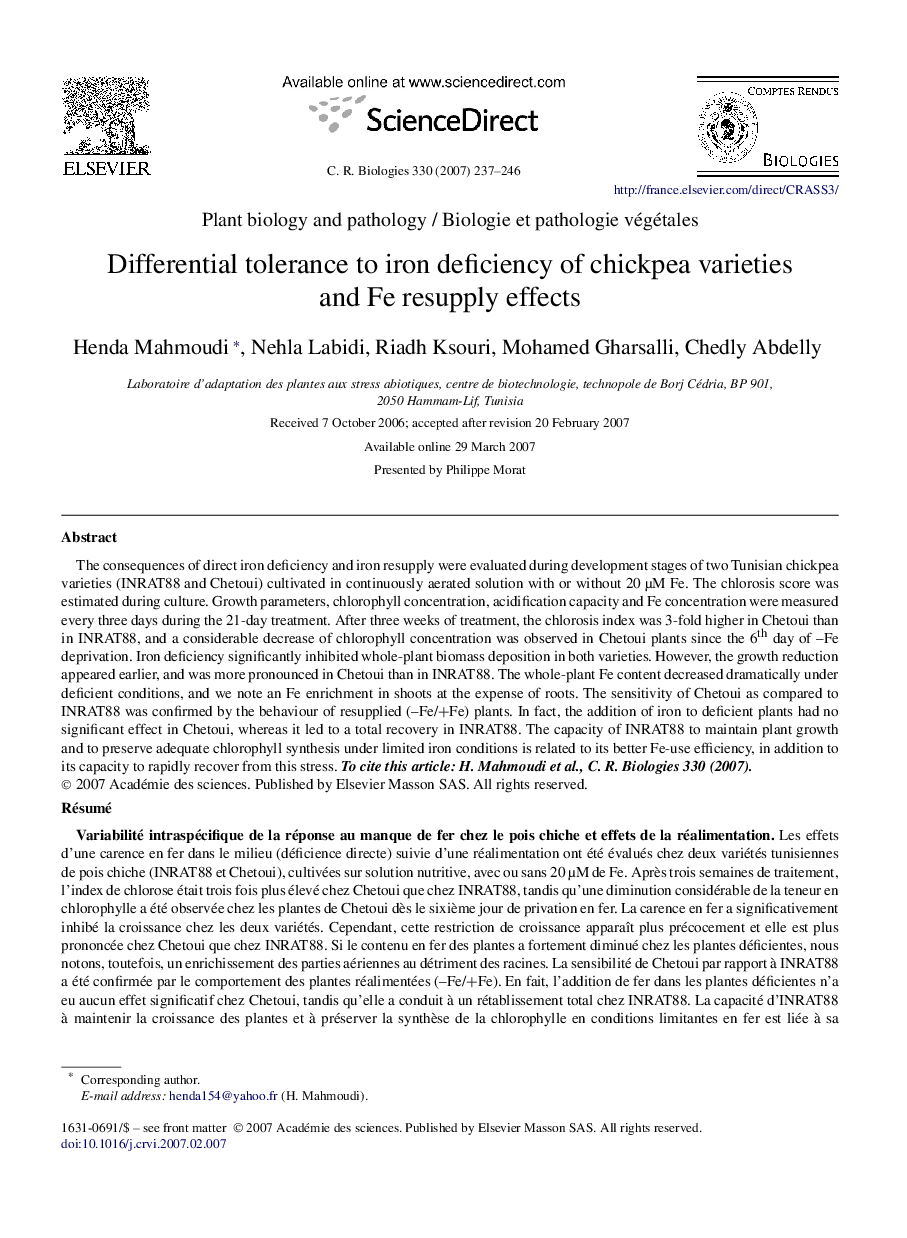| Article ID | Journal | Published Year | Pages | File Type |
|---|---|---|---|---|
| 2784455 | Comptes Rendus Biologies | 2007 | 10 Pages |
The consequences of direct iron deficiency and iron resupply were evaluated during development stages of two Tunisian chickpea varieties (INRAT88 and Chetoui) cultivated in continuously aerated solution with or without 20 μM Fe. The chlorosis score was estimated during culture. Growth parameters, chlorophyll concentration, acidification capacity and Fe concentration were measured every three days during the 21-day treatment. After three weeks of treatment, the chlorosis index was 3-fold higher in Chetoui than in INRAT88, and a considerable decrease of chlorophyll concentration was observed in Chetoui plants since the 6th day of –Fe deprivation. Iron deficiency significantly inhibited whole-plant biomass deposition in both varieties. However, the growth reduction appeared earlier, and was more pronounced in Chetoui than in INRAT88. The whole-plant Fe content decreased dramatically under deficient conditions, and we note an Fe enrichment in shoots at the expense of roots. The sensitivity of Chetoui as compared to INRAT88 was confirmed by the behaviour of resupplied (–Fe/+Fe) plants. In fact, the addition of iron to deficient plants had no significant effect in Chetoui, whereas it led to a total recovery in INRAT88. The capacity of INRAT88 to maintain plant growth and to preserve adequate chlorophyll synthesis under limited iron conditions is related to its better Fe-use efficiency, in addition to its capacity to rapidly recover from this stress. To cite this article: H. Mahmoudi et al., C. R. Biologies 330 (2007).
RésuméLes effets d'une carence en fer dans le milieu (déficience directe) suivie d'une réalimentation ont été évalués chez deux variétés tunisiennes de pois chiche (INRAT88 et Chetoui), cultivées sur solution nutritive, avec ou sans 20 μM de Fe. Après trois semaines de traitement, l'index de chlorose était trois fois plus élevé chez Chetoui que chez INRAT88, tandis qu'une diminution considérable de la teneur en chlorophylle a été observée chez les plantes de Chetoui dès le sixième jour de privation en fer. La carence en fer a significativement inhibé la croissance chez les deux variétés. Cependant, cette restriction de croissance apparaît plus précocement et elle est plus prononcée chez Chetoui que chez INRAT88. Si le contenu en fer des plantes a fortement diminué chez les plantes déficientes, nous notons, toutefois, un enrichissement des parties aériennes au détriment des racines. La sensibilité de Chetoui par rapport à INRAT88 a été confirmée par le comportement des plantes réalimentées (–Fe/+Fe). En fait, l'addition de fer dans les plantes déficientes n'a eu aucun effet significatif chez Chetoui, tandis qu'elle a conduit à un rétablissement total chez INRAT88. La capacité d'INRAT88 à maintenir la croissance des plantes et à préserver la synthèse de la chlorophylle en conditions limitantes en fer est liée à sa meilleure efficacité d'utilisation du fer, en plus de sa capacité à se rétablir rapidement à la suite d'une déficience en fer. Pour citer cet article : H. Mahmoudi et al., C. R. Biologies 330 (2007).
